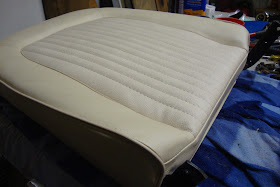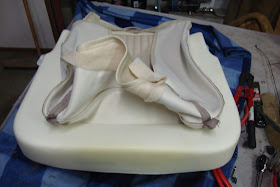In the first installment of "
I've Got it Covered!", I re-upholstered the back seat top and bottom. This was fairly difficult but nowhere near as difficult as the front seats. Firstly there are four sections to the front, instead of two, including the complexity of the seat hinge/latch mechanism in the seat back and the seat tracks on the seat bottom. Additionally, the seat backs have a clipped-on back card and extra high-density foam padding on the back.
So, before I could even begin to re-upholster the front seats, I had to break them down first. This involves first removing the plastic hinge covers from both sides and then removing the hing pins from the pivot shafts attached to the seat bottom. The fun part here is that you have to pry the longer hinge arm away from the pivot and then work the shorter hinge arm away from it's pivot.
 |
| The passenger seat "before" |
 |
| The seat bumpers. These were removed first followed by the hinge covers. |
Once the seat back is separated from the seat base, the seat tracks were removed from the underside of the seat base. This involves removing three springs and four special screws. To get to the screws, you have to shift the track forward and back. The tracks then just lift off with or without the connecting rod between left and right. After the tracks are removed the seat base upholstery can be removed. Removing upholstery on these seats basically just involves cutting the dozens of
hog rings. I used a small bolt-cutter but they make a
hog ring cutter just for this purpose. Once all of the hog rings are removed, the fabric could be folded up and away from the frame... well... sort of. Still remaining are "listing wires" that attach the center section of the upholstery to the frame. These wires give the top and bottom seat centers a contoured shape. Unfortunately, they are attached through the seat foam and to the frame with several more hog rings that needed to be cut. Finally, the fabric and foam can be removed from the frame. However, even after all of this, the frame isn't officially stripped because there are also jute pads, the frame listing wires, and burlap with wires weaved through it all still hog-ringed to the frame. After all of these parts are cut away, only THEN can the frame be cleaned and repainted.
 |
| The seat tracks. |
 |
| Tracks removed, hinges separated. |
 |
| Cutting away the hog rings |
 |
| Bottom rings removed but listing wire still attached. |
 |
| Listing wires cut away. Original bottom seat foam. |
 |
| Seat foam removed. Wire-infused burlap, jute padding (around edges), and frame listing wires (oddly shaped fat paper-coated wires hog-ringed to the springs). |
 |
| Stripped seat bottom frame. |
This whole stripping process was then repeated on the seat back frame. However, the seat back also contains a mechanism for the seat latch in addition to high density foam pads glued to the back panel of the seat. With all of this removed, the seat back could then be cleaned and painted.
 |
| Seat back after removing the seat back card. |
 |
| Seat back fabric and foam laid back showing listing wires and more burlap. The high-density foam for the seat back can be seen still glued to the original foam. |
 |
| Back of seat back with high-density foam strips still attached. Top section can be seen in above pic. |
I think that the optimal method for cleaning the seat frames would have been
chelation, media blast, or dipping. As it was, all I had at my disposal for the task was my drill, spinning a 2" wire cone brush. My goal was to knock off loose rust, paint, and debris. I then coated the frames with Ospho and left them to sit in the sun. After it dried, I rinsed them with water and a scrub brush, dried them with a heat gun, and then rubbed them down with lacquer thinner. I followed up with a coating of self-etching primer and finally several coats of semi-gloss engine enamel.
 |
| Seat frames after wire brush and ospho. |
 |
| After self-etch primer. |
kk
 |
| After paint test fitting high density foam. |
One of my many visions for this car is a set of headrests. This poses a bit of a problem. Firstly, although headrests were an option in 1968, they were rarely purchased. This means that an original set of 1968 headrests are very expensive, on the order of $400 a set expensive and that's before new upholstery and brackets.
In 1969, headrests became more standard and were shared by the Mercury Cougar (and a few other Ford/Mercury/Lincoln models) and the best news yet, they are
reproduced today. However, the difference between 1968 and 1969 headrests are many, including the fact that the 68 headrests had two posts instead of one flat bar. One option that has that 68 look and feel is the "
Sport Seat Style" headrests available at the various vendors. Still at $300 a set, they're out of my ballpark. A less expensive option are the more generic "
Headrest Conversion" available from the vendors for around $200, a more viable option but appear to be non-adjustable which is a bit too cheesy even for me. So, the clear winner in my mind was the 1969 style headrest.
 |
| The ultimate goal |
As of this writing, my intention is to find good original ones from a Mustang or Cougar at a price below $80 apiece which happens to be the repro price (minus upholstery). However, just because I don't yet have the headrests, doesn't mean that I can prepare for them. The problem is that although the 1968 and 1969 seat frames are damned-near identical, the headrest bracing is way different with the 1969 seat having a lot more structural bracing at the top of the seat back frame as the picture to the right shows taken of a 69 Cougar seat back and headrest. So, I needed to simulate that option while providing legitimate structural integrity for the headrest so it doesn't just break away in the event of an actual accident. Fortunately, the
sliding brackets for the 69 headrest are also reproduced and are inexpensive at $20 each so I bought a pair.
After a bit of thought and lots of measuring and researching as many images of 69 seat backs as I could find, I came up with a compromise. I think that this solution is not nearly as strong as the "real" 69 frame but is much better than nothing IMHO. The pictures below are pretty self-explanatory but basically, I just welded a 1/8" steel plate to a 1" square tubing. I notched the tubing to bring the headrest bracket into alignment with where it needed to sit in the seat frame. The four holes in just align with the existing holes in the frame and are set to center the plate with the center of the seat back. Four 1/4" captive nuts are welded to the plate for the bracket to attach to. The bracket was then painted and bolted to the frame.
 |
| Raw materials for the new headrest bracket. |
 |
| Headrest bracket assembled. |
 |
| headrest bracket installed. |
The rest of the seat back could then be assembled including re-installing the seat latch mechanism and using contact adhesive to re-attach the high-density foam pads. Since the front seat burlap with integral wires were pretty much rotted to uselessness, I opted to use two layers of burlap to isolate the foam from the springs. The jute edge padding was also beyond use so I hog-ringed a strip of 1/2" medium density foam around the edge of the frame and then hog-ringed the original listing wire to the springs. I cut splits in the foam every 4" or so because the listing wires for the upholstery are hog-ringed through the foam and onto the thick listing wires attached to the frame. The upholstery listing wires were cut out of the original covers and threaded through the sleeves in the new ones.
The real work can then be started; pushing hog rings around the listing wires, pushed through the foam slits, and clamped to the wires on the seat frame. This is by far, the most difficult part of the re-upholstery job in my opinion and I really didn't "get it" until I was practically on the last seat.
 |
| High density foam glued back onto the frame. |
 |
| Seat back prepared for foam. Burlap, edging, and listing wire. |
 |
| Foam in place. |
 |
| Listing wire being inserted into the upholstery sleeve. |
 |
| Back foam glued to high-density foam and listing wire ringed to to the seat frame. |
The process of hog ringing the upholstery to the frame was really not all that difficult although it could, at times, be one of the more physically taxing tasks since the upholstery had to be pulled taut, while massaging the foam to take up the slack and get the wrinkles out while making sure the edge piping is correctly aligned with the seat edges.
The front seat backs were finished up by punching holes to make room for the back card clips and the latch release lever shaft on the side of the seat. The card was then popped on completing the seat back.
 |
| Installing the back card. |
 |
| Done. Back. |
 |
| Done. Front. Not too thrilled with the listing wire job on this one. |
The process was then repeated generally the same for the seat bottoms which were finished up by cutting slots for the hinge posts and latch bracket.
 |
| Seat bottom ready to go. |
 |
| Listing wires ringed in. |
 |
| Seat bottom hog rings. |
 |
| Done. Note the unevenness of the listing wires again. I'm thinking every 3 inches or so is what it would take to get this perfect on both the fabric and seat frame wires. |
 |
| Holes punched for the hinge pivots. |
The seat back was then re-united with the bottom by first inserting the short hinge onto its post and then prying the long side onto its post while trying not to drive a hole into the new fabric. Finally, the seat tracks were lubricated with some lithium grease and missing springs were replaced and the connecting rod was adjusted. Normally, the hinge covers would be replaced at this point, but I'm still working on repainting my originals so they aren't pictured here. Also, the seat bumpers were replaced (not shown). They get pretty beat up during their lives and inexpensive
repros are available.
 |
| Back and bottom reunited. |
 |
| Seat tracks installed. |
The seats were next re-installed in the car and the red interior is history.
 |
| Done! |
You might notice the lack of headrest holes. No point in cutting holes if I don't have them yet but the brackets are there for when I do.






























































